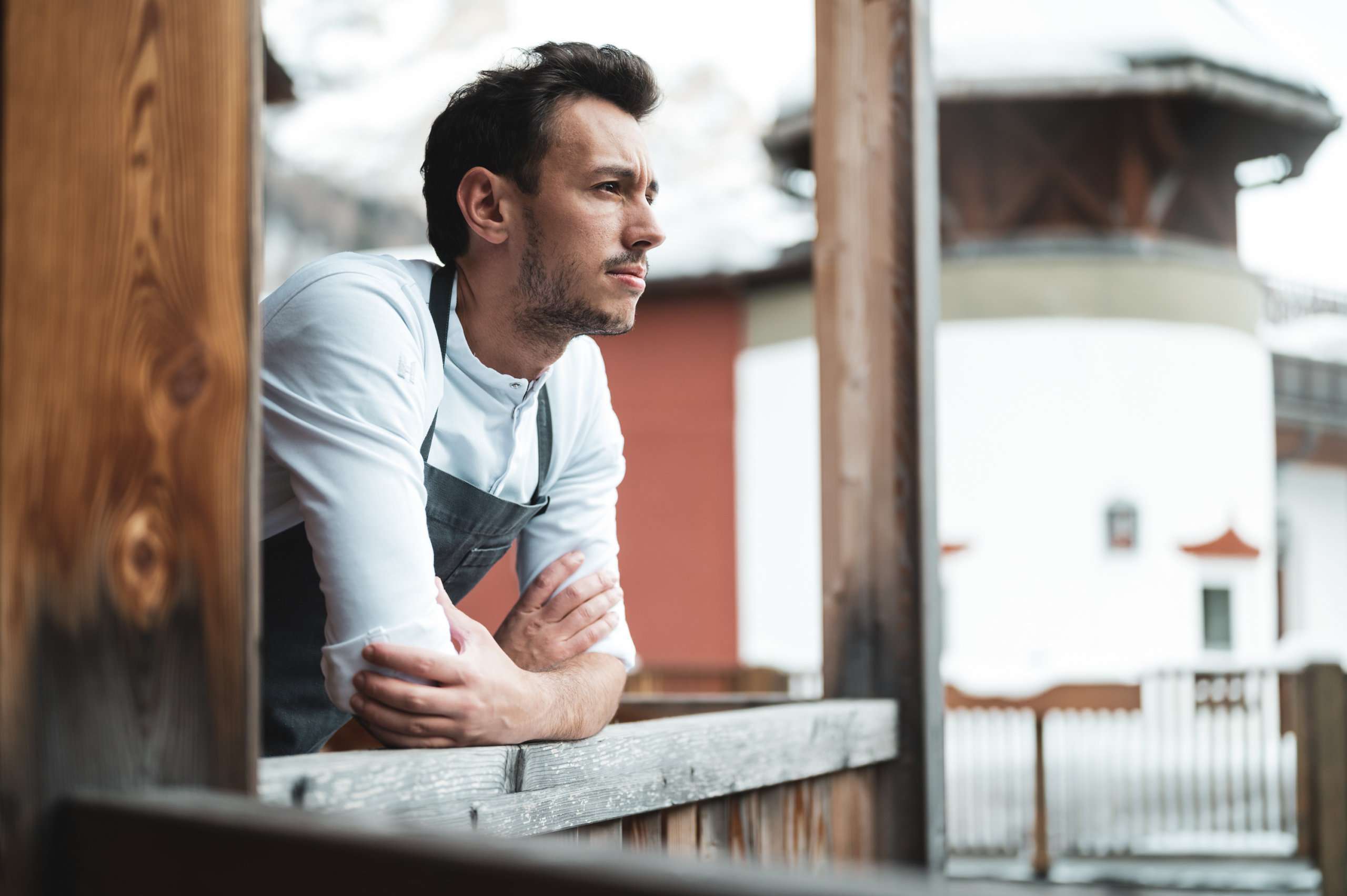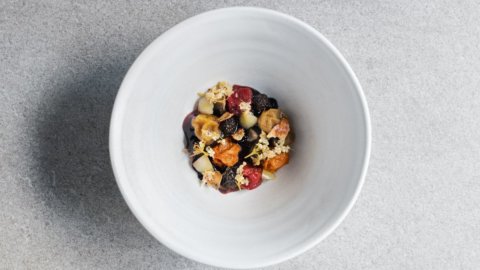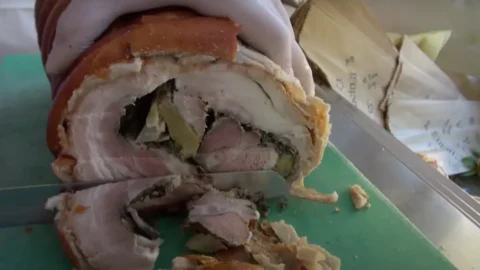What can push a young chef in his thirties, he has flanked for nine years by a sacred monster of Italian catering, such as Norbert Niederkofler, until you get to be Head Chef of the legendary restaurant St. Hubertus of San Cassiano, 3 stars in the Michelin Guide, 4 hats and 19 points in Gault Millau, frequented by an exclusive international clientele, to leave such a prestigious position for a district lost in the mountains of the Bergamo area, far from everything, but totally immersed in nature a stone's throw from the clouds?
You ask him if he's crazy. And he candidly replies that in life you always need a little madness. Certainly madness but also a lot of determination in wanting to swrite a new page in catering, prefiguring innovative scenarios of a cuisine that seeks the maximum synthesis of its inspiration in the authenticity of flavors without giving in to any mediation or compromise, with a circular project that can enhance mountain products, traditions and its culture and that uses innovative techniques with a look at our roots".
Said like this, it seems only a passionate act of love, but behind this choice there is a rigorous path of perfectionism that led the young Michele Lazzarini to travel around Europe always in the constant search for that synthesis of authenticity which is his philosophy imperative, from Gualtiero Marchesi's Albereta, to the Kulmhotel in St Moritz, from Crippa Piazza d'Uomo, to the Studio restaurant in Copenhagen, from Azurmendi in Spain to Virgilio Martinez's Central South America, and to Boragò by Rodolfo Guzman, and then moved to the Faviken of Magnus Niksson et al Name of Renee Redzepi.
An extraordinary journey that is now synthesized in an experiential amalgam that will take shape in June in a rural settlement that dates back to 1400, Contrada Bricconi, in Oltressenda Alta, a group of abandoned stables, unknown even to him who was born in Gandellino, ten minutes by car from here, which have only been recovered for a decade for an interesting and somewhat visionary project. A small ancient world of four friends led by James Perletti, today thirty-six years old with a degree in Agricultural Science and Technology, cheesemaker, milker, raker and gardener. Thanks to a municipal announcement, the four have brought back to life the old premises of the totally abandoned district by starting a breeding of about 35 heads of Alpine Gray cows, from which cheeses are obtained that have the taste of the cheeses of the past, a sale of extraordinary because the animals mostly eat maison hay in winter and fresh grass in summer, about 20 pigs, fed with whey obtained from the processing of the cheese itself, corn flour, soft wheat bran. In short, a place where the earth in its most authentic, historical and cultural meaning is sovereign.
The Search for a Further Formulation of Cook's Philosophy The Mountains by Norbert Nieder Niederkofler
Lazzarini met this reality four years ago, he was enthusiastic about it. The four young people from Contrada appeared to him like four knights traveling towards a natural-environmental dimension totally in line with his ethical-gastronomic principles: “We are farmers, we are in love with this place and our animals that live there. Running to produce, sell, deliver, are the area in which our passion is examined for sustainability without which the Contrada would return to abandonment". And from that moment he began to think that this was the right place to develop his own original idea of cooking like further personal formulation of Cook's philosophy The Mountains by Norbert Nieder Niederkofler so mountain cuisine can and must make its contribution to the sustainable growth of the planet by promoting the protection of the territory and of animal and plant species.
“Il dream was to go back to my land, to do something in the places that are home for me. But always in line with the philosophy that Norbert himself is pursuing. I made the decision to get involved for a restaurant that celebrates mountain culture and sustainability». And that dream is now coming true. The Contrada Bricconi restaurant will see the light of day in June: about thirty seats in three rooms where everything from the furnishings to the environment has the sense of a full immersion in the mountains in ways and times, very distant from the urban way of life. The preparatory work was painstaking: quality meats and cheeses are obviously ensured on site, for the rest small artisans of taste and companies in the area were involved. A poultry farm is already in the works, with rabbits, chickens, ducks, quails, guinea fowls and geese. Much space will be reserved for vegetables, which will be sourced from a 5-hectare vegetable garden in Castione della Presolana. For fish, exclusively fresh water, agreements have been made with a gentleman who has tanks for breeding trout and char, fed directly from the spring; therefore, with very pure water which had ceased its activity and which will now be resumed and relaunched
“We want to give life to a 100% sustainable cycle – says Lazzarini – developing a real center not only for production and catering, but also for the study of agriculture and mountain farming, in collaboration with universities. And this completes the picture of the ambitious program of the group of friends who appear more and more motivated to do something new and important.
“Together with the guys from Contrada Bricconi, we are creating a new project – concludes the chef – which will encompass most of my journeys, a project based on the mountain area and its sustainability”. In short, a high-level cuisine that is able to express the soul of the mountain gastronomically interpreted with modern knowledge that enhances its purity and identity. And something tells us that sooner or later a star will come to rest even on a remote district in the mountains of the Bergamo area.
The recipe proposed by chef Lazzarini is his vision of the Curd transformation of milk into a solid mass by the enzymes present in the rennet. “A process of the dairy tradition of our valleys, the first step for the preparation of the cheese. By tasting the freshly prepared curd – explains the chef – I decided to work this transformation using it as a very delicate dessert. Here is my curd, a traditional process combined with my mountain cuisine. The concept of this dish is the union of the dairy tradition with the research of the product and of the mountain cuisine”.

The recipe of the curd with mountain scents
ingredients for 4 people
fresh milk curd
250 ml fresh bread
250ml fresh milk
50 gr sugar
9 g animal rennet
Carnelian sorbet
240 ml carnelian juice
250 ml water
187 gr sugar
17 g glucose
Rhubarb compote
500 g rhubarb (fresh)
175 gr sugar
10 g verbena (fresh)
5 g thyme (fresh)
Chips in topinambur
nr 2 Jerusalem artichokes
100 ml water
100 gr sugar
Elderberry tomatoes
12 cherry tomatoes of various colors (fresh)
50 g elderflower syrup
Salt to taste
Dehydrated prunes
2 plums (fresh)
30 g elderflower syrup
salt to taste
Other ingredients
20 g black walnuts
20 g carnelian juice
Process for fresh milk curd
Combine all the ingredients and bring them to 38°C, add the rennet and divide the mixture into 4 cups, let it curdle at room temperature.
Carnelian sorbet
Combine all ingredients, except the carnelian juice and bring to 29° brix, add the juice and cool. Cream in an ice cream maker.
Rhubarb compote
Peel and brunoise the rhubarb, add the sugar and let it macerate for 1 hour.
After this period of time, bring the mixture to the boil and then place it in the refrigerator for 1 whole night. The following morning, filter everything and bring the juice obtained up to 65° brix, add the rhubarb and bring to the boil for about 1 minute. Combine the fresh herbs and put the mixture in an airtight jar, pasteurize at 86°C for 18 minutes in a steam oven.
Jerusalem artichoke chips
Wash the Jerusalem artichokes well and cook them at 100°C in a steam oven for about 1 hour, once soft, cut them in half and remove the pulp. Prepare a 1:1 syrup by combining the water and sugar and bringing them to the boil. Cool the syrup and dip the Jerusalem artichoke peels in it, bake at 180°C for 5 minutes with the oven fan on speed 2.
Elderberry tomatoes
Wash the cherry tomatoes and cut them into the skin with a small knife, blanch them for a few seconds, cool them in water and ice and then peel them. Place them on a piece of parchment paper, sprinkle them lightly with salt and brush them with the elderflower syrup. Place them in a dryer at 55°C, turn them over and brush them every 20 minutes, repeat the operation until the tomatoes are semi-candied.
Dehydrated prunes
Wash the plums and cut them in half, pitting them, then work them in the same way as the elderberry tomatoes.
Carnelian juice
Obtain the juice by placing the carnelian in a steam juicer. Cool before use.
Place the rhubarb compote at the base of the dish, compose a fruit salad with the chips, the fermented gooseberry, the cherry tomatoes and the dehydrated plums. Arrange everything on the rhubarb compote, add the elderflowers and continue with a layer of cornelian sorbet, covered with fresh rennet, finally add the juice on the edge of the rennet.





